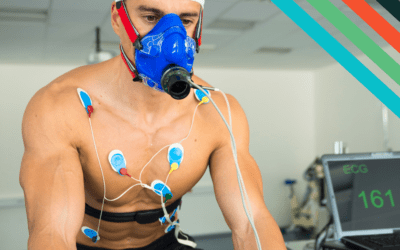Do Squats Count As Cardio?
With the rise of *hybrid training in the last 10 years (*the simultaneous training of strength with conditioning; more simply known in the industry as the blend of strength and conditioning), there has been some concomitant research coming out to try to figure out if conditioning (“cardio”) has to be in the form of running, or if we can just get the desired benefits from something else, like squats.
Every powerlifter is drooling reading this right now. Their disdain for cardio and love for squats is really showing.
While squats can certainly mimic some aspects of cardiovascular training, evidence suggests that they don’t provide the same long-term aerobic adaptations as traditional cardio exercises like running or cycling.
In this article, we’ll clarify that while squats are excellent for building strength and muscle, they don’t provide the same cardiovascular effects as traditional cardio workouts. After reading this blog, if you still need help with your training or performance, reach out to us at Vital Strength Physiology HERE.
Introduction
Squats, bench presses, and lat pulldowns—classic strength exercises we all love to hate—are mostly anaerobic. In simple terms, they rely on those fast, explosive energy systems rather than aerobic sources like fat stores. Vianna et al. (2011) backs this up below (highlighted in red):

But let’s clear up a common misconception right away: humans don’t just “switch” from aerobic to anaerobic modes like flipping a light switch.

Figure from Zrenner, 2002.
It’s more like a dimmer—most strength exercises have elements of both. For example, in the Figure above, you can see that maximal exercise around 30 seconds in duration will have a medium contribution of aerobic energy, a high proportion of lactic anaerobic energy, and a medium but decreasing contribution of alactic anaerobic.
Here’s what dials the anaerobic and aerobic contributions up or down:
- Percentage of Your 1-Rep Max: Lifting closer to your max means more anaerobic energy; go for 20 reps, and you’ll start tapping into aerobic sources.
- Rest Time Between Sets: Less rest? More aerobic energy kicks in. More rest? You’re sticking to anaerobic dominance.
- Duration of the Workout: A three-hour lifting session? You’ll be relying on aerobic systems eventually. Thirty minutes? More anaerobic.
- How You Refuel: Long or intense sessions in the weight room will eventually force you to dip into your aerobic reserves if you don’t refuel properly.
Lost already? Don’t worry, I’ve linked more resources at the end of this blog, including my deep dives on aerobic and anaerobic thresholds. For now, let’s focus on why we’re here: a recent study titled “Cardiorespiratory and Aerobic Demands of Squat Exercise” by Hong et al. (2024).
This study has been making waves online, and right after it was released, a well-known Instagram influencer and researcher, Menno Henselmans, put out a post declaring, “High-rep squats are officially cardio.”
So, was that an accurate take? Honestly, it feels a bit sensationalized to me. In this blog, I’ll break down why.
To all the powerlifters and weightlifters out there who get winded just walking up a flight of stairs, pay attention! Cardio-haters, I see you too. And for the endurance athletes who think lifting isn’t “real” cardio—this might give you a chuckle. Let’s get out of breath sorting this out together.
First, what do we mean, “cardio”?
When we think of “cardio,” we’re usually picturing running, rowing, cycling—you know, those continuous exercises that keep your heart and lungs working over time. On the flip side, resistance exercises like squats typically involve fewer repetitions and shorter muscle contractions. Because squats rely less on aerobic energy and more on larger muscle groups, they’ve been historically classified as anaerobic. But here’s the catch: nearly every exercise involves some interplay between aerobic and anaerobic systems. So, calling resistance exercise purely a strength or power activity might be a bit shortsighted.
What exactly do we mean by “cardio” in this blog? In the fitness world, “cardio” is just shorthand for “cardiovascular exercise” or “cardio-respiratory systems.” We’re talking about primarily aerobic exercises that train your heart (cardiovascular) and lungs (respiratory).
Now, enter the Fick equation, our go-to formula for calculating VO₂max. It looks like this:
VO₂max = Q × a-vO₂diff
Breaking that down further:
VO₂max = (Q = SV × HR) × a-VO₂diff
- VO₂max = the maximum rate of oxygen you can consume and utilize during maximal exercise
- Q=cardiac output
- a-VO₂diff = the difference in oxygen content between the veins and the arteries
- SV= stroke volume
- HR= heart rate

VO₂max is basically a big deal. It’s a key marker of health, closely linked to morbidity, mortality, and overall quality of life. Simply put, the higher your VO₂max, the better your chances of living a longer, healthier life. Endurance athletes obsess over it because it’s one of the three main performance indicators, along with lactate threshold and economy.
So when we talk about the potential to improve your “cardio,” we mean the ability to boost your VO₂max and related health benefits—the maximal amount of oxygen your body can take up and use. According to the Fick equation, this hinges on your cardiac output (Q), specifically your stroke volume and heart rate, as well as your arterial-venous oxygen difference (a-VO₂diff). In simple terms, it’s about how much oxygen your heart can pump to your muscles and how efficiently your muscles can extract that oxygen.
With all this in mind, let’s decide whether high-rep squats can really boost your cardio in the next few sections.
The Case For Squats as Cardio
So, why did Menno jump to the conclusion that “High-rep squats are officially cardio”? Let’s break down the study that led to this statement and see what’s really going on.
The Hong (2024) Study Setup:
- 22 healthy male adults (ages 20-39) with at least one year of resistance training experience.
- Each participant had a squat 1-rep max (1RM) greater than 120% of their body weight.
- Participants visited the lab three times, each session at the same time of day with 3-5 days between visits.
- First visit: Assessed body composition (height, weight, body fat percentage, skeletal muscle mass) and conducted a graded exercise test to determine maximum oxygen consumption (VO₂max).
- Second visit: Determined participants’ 1RM for back squats. Participants were divided into “high strength” and “low strength” groups based on their 1RM relative to body weight.
- Third visit: Participants performed five sets of back squats at 65% of their 1RM, with 10 reps per set and 3-minute rest intervals. Heart rate and oxygen consumption were continuously measured during the exercise.
- They recorded heart rate and pulmonary gas exchange (oxygen consumption and carbon dioxide production) during squats. They also measured ventilation efficiency and peak oxygen consumption during each set.
Key Findings of the Study:
- Squats significantly increased oxygen consumption (VO₂), with participants reaching up to 100% of their VO₂max.
- The peak VO₂ was observed during the 5th set, showing that squats can push aerobic demand to near-maximal levels.
- The “high strength” group experienced a greater increase in VO₂, reaching up to 108% of their VO₂max.
- The “low strength” group topped out at around 93.7% of their VO₂max.
- Takeaway: Those with higher relative muscle strength can push their aerobic demand more during squats.
- Heart rate surged during squats, hitting about 89.7% of max heart rate by the fifth set.
- This shows that squats are not just about muscle strength—they also significantly challenge the cardiovascular system.
- The study classifies squats as high-intensity due to the vigorous cardiovascular response.
- Despite being a resistance exercise, squats involve substantial aerobic components, particularly when performed in multiple sets and at higher intensities.
So, what does this all mean?
Yes, the study found that squats can elicit a very high oxygen demand, even approaching VO₂max. However, here’s the kicker: the authors themselves caution that “further research is needed to investigate the potential effect of squat exercise intervention in improving aerobic capacity.”
Translation: Squats can cause a temporary spike in oxygen demand, but whether they can actually improve your aerobic capacity (VO₂max) is still up in the air.
In the next section, let’s dive into the case against squats as cardio and explore the other side of the coin.
The Case Against Squats as Cardio
Reason 1: Blood Flow Occlusion
When you lift heavy loads, like in a barbell back squat, a large amount of muscle is recruited, temporarily cutting off blood flow to those muscles. In the case of squats, your legs experience this temporary blood flow occlusion. This causes a spike in blood pressure and heart rate as your body scrambles to deal with the high levels of CO₂ building up in those areas. The result? You’re left gasping for air, not because the oxygen demand is sky-high, but because your body is compensating for the reduced blood flow while recruiting those high-level motor units (hello, type 2 fast-twitch fibres).
Reason 2: Just Because You’re Gasping for Air Doesn’t Mean It’s Cardio
People often think that anything making them sweat or leaving them breathless qualifies as cardio. But feeling exhausted isn’t the same as cardiovascular exercise. Trying to open a jar sealed by a bodybuilder? That’s not cardio. Holding your breath underwater? Still not cardio. Even if something spikes your heart rate—like, say, taking a line of cocaine—it doesn’t make it cardio. Cardiovascular exercise is more than just getting sweaty and winded. We need an increase in oxygen consumption at the muscle level by the mitochondria (the powerhouse of the cell), not just a speedy heart rate.
Reason 3: Just Because It Increases the Demand for Oxygen Doesn’t Mean It’s Cardio
Cardio isn’t just about increasing oxygen demand. True cardiovascular exercise raises the metabolic demand of the entire system. This means increasing the need for oxygen in a way that leads to heightened breathing rate, heart rate, sweating, and blood flow to the muscles in action. In exercise physiology, we measure this demand with “VO₂,” the volume of oxygen consumption. At maximum exertion, we measure “VO₂max” to determine cardiovascular and respiratory demand. While heavy squats can temporarily increase VO₂, it doesn’t necessarily equate to cardio training in the long term. We care about the long term because the whole reason why we’re concerned about this topic is because we know that training the aerobic system can have a very profound effect on health outcomes and disease prevention, not to mention better performances at endurance events!
Reason 4: Acute Increases in VO2 Do Not a Long-Term Adaptation Make
Sure, you can hit 65% of your VO2max with squats, but it’s not the same as sustaining that level over an extended period, like you can with walking or jogging. Building aerobic capacity requires maintaining a specific intensity for long periods to amass the volume necessary for adaptation. You might also reach 65% of your VO2max by doing kettlebell snatches for 12 minutes, but that doesn’t mean it will yield the same cardiovascular benefits as a sustained aerobic workout.
So, while squats can temporarily spike your oxygen demand and make you feel like you’ve just run a marathon, that doesn’t necessarily mean they’re going to improve your long-term aerobic capacity.
Volume, Baby! And how much?
You just can’t hit the same volume with a barbell on your back!
In the Hong et al. study, they used 65% of the participants’ 1RM for squats, doing sets of 10 with 3 minutes of rest in between. Sure, they saw an acute “increase” in oxygen demand, but here’s the kicker: if each set takes 1 minute and you rest for 3 minutes, you’re spending 4 minutes to get just 1 minute of actual aerobic work.
Now, let’s do some quick math. In a typical Zone 2 cardio session at 65% of your VO2max, a beginner can easily accumulate 20-30 minutes of aerobic work. Intermediate and advanced athletes? They can go for 2 hours or more. To match that in squats, you’d need to crank out around 200 reps (10 squats per set to accumulate 20 sets, equaling 20 minutes of work at the absolute beginner level). And how long would that take? Buckle up—80 minutes, given the 3-minute rest periods between sets.
And that’s not even touching on how wrecked you’d feel afterward. After 200 squats, you’d be so sore you’d have to skip training for days. In contrast, real aerobic conditioning is low impact and effective, allowing you to train the next day and pretty much every day after a Zone 2 session.
What’s the amount of training volume you need to elicit an aerobic adaptation?
In simple terms, the “dose-response relationship” means the effects of exercise on your health depend on how much and how hard you exercise. The higher the dose, the higher the response. The more exercise or the higher the intensity, the greater the health benefits—up to a point, of course.
To give you a concrete example of the “dose” of aerobic exercise needed to see changes, let’s look at studies that focus on health outcomes, like the one by Donejko et al. (2014).
Objective:
To investigate how different amounts (volume) and intensities of exercise impact health markers like body composition, cardiovascular health, and fitness, especially at levels below the typical international exercise guidelines.
Method:
- 72 healthy adults aged 20-65.
- Participants were split into six groups: one control group and five 13-week exercise programs:
- 10-minute brisk walking, 1×/week
- 10-minute brisk walking, 3×/week
- 30-minute brisk walking, 3×/week
- 60-minute brisk walking, 3×/week
- 30-minute running, 3×/week
- Health markers like blood pressure, body composition, fasting lipids and glucose, and VO₂max were assessed before and after the program.
Key Findings:
- Improvement with 30-Minute Sessions: Significant health benefits were observed in the groups that exercised for at least 30 minutes per session, 3 times a week. Improvements included reduced waist circumference and increased aerobic capacity (VO₂max).
- Intensity Matters: The group doing 30-minute running sessions reaped even more benefits, including improved triglyceride levels, indicating that higher intensity can lead to greater health improvements.
- Minimal Benefits from Shorter Sessions: Shorter sessions of 10 minutes showed limited health benefits, suggesting there’s a minimum duration and intensity threshold needed to see noticeable changes.
- Optimal Exercise Dose: The study suggests that 90 minutes of moderate-intensity exercise per week (30 minutes, 3 times a week) is effective for improving health in generally healthy and active adults. This supports the dose-response relationship between exercise and health.
In other words, to really move the needle on your aerobic fitness, you’re looking at a consistent routine of moderate-intensity exercise, not just a few quick sets here and there.
The implications for daily training really show that consistency over acute quantity matters:
- Regular Sessions: Aim for at least 30 minutes of exercise, three times a week. This consistency is key to reaping the health benefits of regular physical activity. Of course, if you’re training for something specific or are an athlete with an already high fitness level, this amount of training would likely need to be more.
- Intensity Matters: Incorporating higher-intensity exercises, like running, can boost certain health markers even more than moderate-intensity activities.
- Keep It Practical: Committing to just 90 minutes of moderate exercise spread across the week can lead to significant health improvements, making it more doable for those with tight schedules.
What’s the Minimum Effective Dose for conditioning? According to Spiering et al. (2021), you can maintain your aerobic gains with surprisingly little effort:
- Frequency: Just 2 sessions per week.
- Volume: As little as 13 minutes per session.
- Intensity: Keep it at your typical training level, maintaining heart rate around 82-87% of your max.
The bottom line? Dose is king when it comes to maintaining aerobic fitness, even if you’re dialing back the frequency and volume of your workouts.
What Do the CSEP Guidelines Say? The Canadian Society for Exercise Physiology (CSEP) currently recommends 150 minutes of moderate to vigorous intensity exercise per week and this is what we typically recommend, broadly speaking, to our clients.
Could it be dangerous?
When you lift heavy weights, your blood pressure can skyrocket, putting some extra strain on your cardiovascular system. That spike in blood pressure can stress the heart and blood vessels, potentially leading to issues like heart attacks, strokes, or long-term blood vessel damage. This risk is especially concerning if you already have hypertension or heart conditions. For these folks, that added pressure can seriously increase their risk of cardiovascular events.
I mention this because resistance training will acute raise your blood pressure more than a low and slow aerobic training session in the short term, so it should be mentioned that trying to get your conditioning through squats might not be feasible for yet another reason.
Now, what does the Canadian Society for Exercise Physiology (CSEP) say about this? Here’s their current stance:
- Your blood pressure should be 160/90 mmHg or lower at rest before you start exercising.
- If it’s higher, you need to get the all-clear from an exercise professional first.
- High blood pressure (BP) is one of the leading risk factors for cardiovascular disease (CVD) (Schultz et al., 2022).
Even with evolving guidelines, exercise professionals should still advise clients with a resting systolic pressure over 140 mmHg (even if they don’t have diagnosed hypertension) to check in with their doctor before jumping into a new exercise routine. Better safe than sorry!
Conclusion
So, do squats count as cardio? Well, they can certainly mimic some aspects of cardiovascular training, like spiking your heart rate and increasing oxygen demand. However, the evidence suggests that while squats can cause a temporary increase in aerobic demand, they don’t provide the same long-term aerobic adaptations as traditional cardio exercises like running or cycling. Squats are great for building strength and can challenge your cardiovascular system in the short term, but if your goal is to improve your VO₂max and overall aerobic capacity, you’ll need a consistent routine of moderate to high-intensity aerobic exercise.
In short, squats are a valuable tool in a well-rounded fitness program, but they’re not a replacement for traditional cardio. If you want the best of both worlds—strength and conditioning—consider a hybrid approach that includes both resistance training and dedicated cardio sessions. And remember, consistency and intensity are key to making real progress, whether you’re lifting heavy or hitting the pavement.
Links to Related Content
Here’s some other posts we’ve made recently that will help you dive deeper on the topic and related topics:
- What is Anaerobic Threshold? (+sample workouts!)
- What is Aerobic Threshold? (+ sample workouts!)
- Do I Need Lactate and VO2 Max Testing?
- Goal Setting for Endurance Athletes
- Which smartwatch should I buy in 2024 to get the most out of my endurance training?
- Endurance Coach – Is it worth it?
- How to test your fitness with the 20m shuttle run test. (All you need is 20m and your phone!)

More About The Author
Carla Robbins, Owner of Vital Strength and Physiology Inc
Carla’s journey into the world of endurance training, strength and conditioning, and exercise physiology began with her Undergraduate Degree in Exercise Physiology at the University of Calgary and continued into her graduation with a Master’s in Exercise Physiology in 2016. Between working for the Canadian Sports Institute to the creation of her company Vital Strength and Physiology Inc, Carla is driven by a desire to find better ways to address complex cases in professional and everyday athletes and individuals.
References
Bassett, D. R., & Howley, E. T. (2000). Limiting factors for maximum oxygen uptake and determinants of endurance performance. In Med. Sci. Sports Exerc (Vol. 32, Issue 1). http://www.msse.org
Canadian Society for Exercise Physiology. (2020, October 15). Canada’s first-ever 24-hour movement guidelines for adults help make the whole day matter. [Webpage]. https://csep.ca/2020/10/15/canadas-first-ever-24-hour-movement-guidelines-for-adults-help-make-the-whole-day-matter/
Cornelissen, Véronique A; Fagard, Robert H. Effect of resistance training on resting blood pressure: a meta-analysis of randomized controlled trials. Journal of Hypertension 23(2):p 251-259, February 2005.
Hong, S., Oh, M., Oh, C.-G., Lee, H.-D., Suh, S.-H., Park, H., Lalande, S., Tanaka, H., & Jeon, J. Y. (2024). Cardiorespiratory and aerobic demands of squat exercise. Scientific Reports, 14(1), 18383. https://doi.org/10.1038/s41598-024-68187-z
Lambrick, D. M., Faulkner, J. A., Rowlands, A. v., & Eston, R. G. (2009). Prediction of maximal oxygen uptake from submaximal ratings of perceived exertion and heart rate during a continuous exercise test: The efficacy of RPE 13. European Journal of Applied Physiology, 107(1), 1–9. https://doi.org/10.1007/s00421-009-1093-7
Melo, X., Arrais, I., Marôco, J. L., Ribeiro, P. N., Nabais, S., Coelho, R., Reis, J., Angarten, V., Fernhall, B., & Santa- Clara, H. (2023). Effects of kettlebell swing training on cardiorespiratory and metabolic demand to a simulated competition in young female artistic gymnasts. PLoS ONE, 18(4 April). https://doi.org/10.1371/journal.pone.0283228
Pezze, P. D., Ruf, S., Sonntag, A. G., Langelaar-Makkinje, M., Hall, P., Heberle, A. M., Navas, P. R., van Eunen, K., Tölle, R. C., Schwarz, J. J., Wiese, H., Warscheid, B., Deitersen, J., Stork, B., Fäßler, E., Schäuble, S., Hahn, U., Horvatovich, P., Shanley, D. P., & Thedieck, K. (2016). A systems study reveals concurrent activation of AMPK and mTOR by amino acids. Nature Communications, 7. https://doi.org/10.1038/ncomms13254
Rodriguez, D., Polito, M., Bacurau, R., Prestes, J., & Pontes, F. (2011). Effect of Different Resistance Exercise Methods on Post-Exercise Blood Pressure.
Schultz, M. G., Currie, K. D., Hedman, K., Climie, R. E., Maiorana, A., Coombes, J. S., & Sharman, J. E. (2022). The Identification and Management of High Blood Pressure Using Exercise Blood Pressure: Current Evidence and Practical Guidance. In International Journal of Environmental Research and Public Health (Vol. 19, Issue 5). MDPI. https://doi.org/10.3390/ijerph19052819
Spiering, B. A., Igo Mujika, I., Sharp, M. A., & Foulis, S. A. (2021). Maintaining Physical Performance: The Minimal Dose of Exercise Needed to Preserve Endurance and Strength Over Time. www.nsca.com
Thomas SG, Goodman JM, Burr JF (2011). Evidence-based risk assessment and recommendations for physical activity clearance: established cardiovascular disease. Appl Physiol Nutr Metab, 36(S1): S190-S213, https://doi.org/10.1139/h11-050.
Vianna, J. M., Lima, J. P., Saavedra, F. J., & Reis, V. M. (2011). Aerobic and Anaerobic Energy During Resistance Exercise at 80% 1RM. Journal of Human Kinetics, Special Issue, 69–74. https://doi.org/10.2478/v10078-011-0061-6
Zrenner, M. (2022). From Raw to Big Data in Endurance Running. Application of Data Science Techniques for Knowledge Creation from Wearable Sensor Data.



